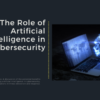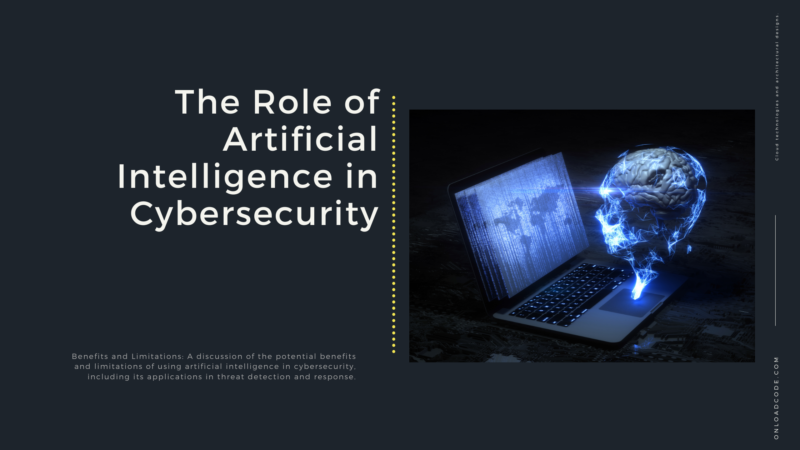In today’s fast-paced digital landscape, where cyber threats continue to evolve and grow in sophistication, organizations are increasingly turning to artificial intelligence (AI) to bolster their cybersecurity defenses. AI offers the potential to revolutionize the way we detect, analyze, and respond to cyber threats, but it’s important to understand both its benefits and limitations. In this article, we will explore the role of artificial intelligence in cybersecurity, examining its potential benefits and the challenges it faces.
This is the 4th article on the Cybersecurity: Securing the Digital Landscape series. In this article, we are discussing The Role of Artificial Intelligence in Cybersecurity.
Understanding Artificial Intelligence in Cybersecurity
Artificial Intelligence (AI) is a branch of computer science that focuses on the development of intelligent machines capable of performing tasks that typically require human intelligence. In the context of cybersecurity, AI refers to the application of machine learning algorithms and techniques to enhance the detection, analysis, and response to cyber threats. Let’s explore the key aspects of understanding AI in cybersecurity.
What is Artificial Intelligence in the Context of Cybersecurity?
Artificial Intelligence in cybersecurity involves the use of algorithms and models that can learn from data, detect patterns, and make informed decisions to identify and mitigate security risks. It encompasses various techniques, including machine learning, natural language processing, deep learning, and cognitive computing.
AI algorithms analyze large volumes of data, such as network traffic logs, user behavior patterns, and system vulnerabilities, to identify potential threats and anomalies. By learning from historical data, AI systems can continuously improve their ability to detect and respond to emerging cyber threats.
The Benefits of AI in Cybersecurity
AI brings several significant benefits to the field of cybersecurity:
a. Enhanced Threat Detection:
- AI algorithms can quickly process vast amounts of data, including network traffic, system logs, and user activities, to identify suspicious patterns or behaviors that may indicate an ongoing attack.
- Machine learning models can adapt and evolve over time, allowing them to detect new and evolving threats that traditional rule-based systems might miss.
b. Real-Time Response:
- AI-powered systems can autonomously respond to cyber threats in real-time, automatically taking actions to mitigate the impact of an attack.
- Automated incident response enables faster reaction times, reducing the window of opportunity for attackers and minimizing the damage caused.
c. Advanced Behavioral Analysis:
- AI algorithms can analyze user behavior and network patterns to establish a baseline of normal activities. Any deviations from this baseline can trigger alerts for potential insider threats or compromised accounts.
- Behavioral analytics can help identify anomalies in real-time, allowing for early detection and response to potential security breaches.
The Limitations of AI in Cybersecurity
While AI brings immense potential to enhance cybersecurity, it also faces certain limitations:
a. Adversarial Attacks:
- Cybercriminals can exploit vulnerabilities in AI systems through adversarial attacks. By manipulating input data, attackers can deceive AI models and trick them into making incorrect decisions or bypassing security measures.
b. False Positives and Negatives:
- AI algorithms may generate false positives, flagging legitimate activities as threats, which can result in unnecessary disruptions and increased operational costs.
- False negatives occur when AI systems fail to detect sophisticated or novel attacks that haven’t been encountered before, leading to undetected security breaches.
c. Lack of Contextual Understanding:
- AI systems may struggle to understand the contextual nuances of specific cybersecurity incidents. They may require human intervention to accurately analyze the severity and impact of an attack and determine appropriate response actions.
Incorporating human expertise, continuous monitoring, and iterative improvement are essential to overcome these limitations and optimize the effectiveness of AI in cybersecurity.
Understanding the fundamental concepts of AI in the context of cybersecurity provides a solid foundation for exploring its practical applications and implications. In the following sections, we will delve deeper into various use cases of AI in cybersecurity, showcasing its effectiveness in threat detection, incident response, and user behavior analysis.
Use Cases of AI in Cybersecurity
Artificial Intelligence (AI) has revolutionized the field of cybersecurity by enabling more advanced and efficient threat detection, response, and prevention. Let’s explore some prominent use cases where AI is making a significant impact:
Threat Detection and Analysis:
a. Malware Detection:
- AI algorithms can analyze file behavior and characteristics to identify potential malware. They can detect previously unknown malware strains based on their behavior patterns, helping security systems stay ahead of emerging threats.
- Machine learning models can classify files as benign or malicious, leveraging features like file attributes, code analysis, and network behavior.
b. Intrusion Detection:
- AI-powered Intrusion Detection Systems (IDS) can detect and flag suspicious network activities that may indicate a cyber attack. These systems use machine learning to identify abnormal patterns in network traffic and identify potential threats.
- Anomaly detection techniques, such as clustering algorithms and outlier detection, can help identify deviations from normal network behavior, allowing for early detection of intrusions.
c. Insider Threat Detection:
- AI algorithms can analyze user behavior and identify anomalous activities that may indicate insider threats, such as unauthorized data access or abnormal data transfers.
- By monitoring user actions, AI systems can detect patterns of suspicious behavior and generate alerts for further investigation.
Incident Response and Mitigation:
a. Automated Incident Response:
- AI-powered systems can automate the incident response process, enabling rapid and efficient mitigation of cyber threats.
- Automated responses may include isolating compromised systems, blocking malicious IP addresses, or implementing temporary access restrictions until the threat is neutralized.
b. Predictive Analysis:
- AI algorithms can analyze historical attack data and patterns to predict future attacks. By identifying trends and common attack vectors, security teams can proactively implement preventive measures to strengthen their defenses.
c. Threat Hunting:
- AI can assist security analysts in threat hunting activities by processing large volumes of security data and identifying potential indicators of compromise (IOCs).
- AI-powered threat hunting tools can help identify hidden threats, detect unknown attack techniques, and provide actionable intelligence for further investigation.
User Behavior Analysis:
a. User Authentication and Anomaly Detection:
- AI algorithms can analyze user behavior patterns, such as login times, locations, and access patterns, to establish a baseline of normal behavior.
- Any deviations from this baseline can trigger alerts for potential account compromise or unauthorized access attempts.
b. Phishing Detection:
- AI can be used to detect phishing emails by analyzing email content, sender reputation, and other contextual factors.
- Machine learning models can identify phishing patterns and provide real-time warnings to users, helping them avoid falling victim to phishing scams.
c. Fraud Detection:
- AI algorithms can analyze transactional data, user behaviors, and historical patterns to detect fraudulent activities, such as identity theft or financial fraud.
- Real-time fraud detection systems powered by AI can help financial institutions and e-commerce platforms prevent financial losses and protect customer accounts.
These are just a few examples of how AI is being applied in cybersecurity. The integration of AI technologies with existing security systems empowers organizations to enhance their threat detection capabilities, respond swiftly to cyber attacks, and stay one step ahead of evolving threats.
In the next section, we will discuss the benefits and limitations of leveraging AI in cybersecurity, providing a balanced perspective on its potential impact.
Benefits of AI in Cybersecurity
Artificial Intelligence (AI) brings numerous benefits to the field of cybersecurity, but it also has certain limitations. Let’s explore both aspects to gain a comprehensive understanding:
Benefits of AI in Cybersecurity:
a. Enhanced Threat Detection:
- AI algorithms can analyze vast amounts of data in real-time, enabling faster and more accurate threat detection. They can identify subtle patterns and anomalies that may be challenging for traditional security systems to detect.
- For example, AI can identify advanced malware variants that exhibit sophisticated evasion techniques, helping organizations stay ahead of evolving threats.
b. Rapid Response and Automation:
- AI-powered systems can automate routine security tasks, such as monitoring and incident response, freeing up security analysts to focus on more complex issues.
- Automated response mechanisms can react to security incidents in real-time, reducing response times and mitigating potential damage.
c. Adaptive Defense:
- AI can learn and adapt to new threats and attack vectors by continuously analyzing data and updating its algorithms. This adaptability allows AI systems to evolve and improve their defense mechanisms over time.
- Machine learning models can dynamically adjust their threat detection capabilities based on evolving patterns, enabling organizations to stay resilient against emerging threats.
d. Scalability and Efficiency:
- AI technologies can efficiently handle large-scale data analysis and processing, making them suitable for managing the ever-increasing volume of security logs, network traffic, and user activities.
- By automating time-consuming tasks, AI reduces the burden on security teams and enables them to focus on strategic initiatives.
It is crucial to understand these benefits to make informed decisions when integrating AI into cybersecurity strategies. By leveraging AI’s strengths while being mindful of its limitations, organizations can enhance their security posture and effectively defend against evolving cyber threats.
In the next section, we will delve into specific applications of AI in different areas of cybersecurity, providing practical insights and real-world examples.
Overcoming Challenges and Ethical Considerations
As organizations leverage AI in cybersecurity, it is crucial to address the challenges and ethical considerations associated with its implementation. Let’s explore key aspects of building robust and trustworthy AI systems and ensuring ethical practices:
Building Robust and Trustworthy AI Systems:
a. Ensuring Data Quality and Integrity:
- High-quality and reliable data is essential for training AI models. Organizations must establish processes to ensure data integrity, accuracy, and relevance.
- Data preprocessing techniques, such as data cleaning and normalization, help eliminate inconsistencies and improve the quality of input data.
b. Incorporating Explainability and Interpretability:
- AI models should provide explanations for their decisions to enhance transparency and trust. Explainability allows security analysts to understand the reasoning behind AI-driven insights and actions.
- Techniques like rule extraction, feature importance analysis, and model-agnostic interpretability methods can help provide explanations.
Addressing Bias and Discrimination:
a. Mitigating Biases in AI Algorithms:
- AI algorithms can inadvertently perpetuate biases present in the training data, leading to discriminatory outcomes or unfair targeting.
- Organizations should implement rigorous testing and validation processes to identify and mitigate bias in AI models. Regular audits and diversity in training data sources can help address these challenges.
b. Fairness and Equity Considerations:
- AI systems should be designed to treat individuals fairly and equally. It is essential to ensure that AI algorithms do not disproportionately impact specific demographic groups or perpetuate existing social biases.
- Fairness metrics, such as disparate impact analysis and equalized odds, can be used to evaluate and mitigate potential biases.
Collaborative Human-AI Partnerships:
a. Recognizing the Importance of Human Expertise:
- While AI brings significant capabilities, human expertise remains critical in cybersecurity. Human analysts possess contextual understanding, intuition, and ethical judgment that complement AI systems.
- Organizations should foster collaborative partnerships between AI systems and human analysts, enabling them to work together to enhance cybersecurity defenses.
b. Continuous Learning and Improvement:
- Human analysts can provide feedback to AI systems, helping them learn and improve over time. This iterative process strengthens the effectiveness and reliability of AI-driven cybersecurity solutions.
By addressing these challenges and ethical considerations, organizations can build AI systems that are more robust, trustworthy, and aligned with ethical standards. Collaborative efforts between humans and AI empower cybersecurity teams to make informed decisions, detect emerging threats, and respond effectively to evolving cyber risks.
In the next section, we will explore practical use cases and applications of AI in various areas of cybersecurity, providing insights into how AI is transforming the industry.
Practical Use Cases of AI in Cybersecurity
Artificial intelligence (AI) is revolutionizing the field of cybersecurity by enabling advanced threat detection, rapid response, and enhanced defense mechanisms. Let’s explore some practical use cases where AI is making a significant impact:
Threat Detection and Analysis:
a. Anomaly Detection:
- AI-powered algorithms can analyze network traffic patterns and user behavior to identify abnormal activities that could indicate a potential cyber threat.
- For example, AI systems can detect unusual spikes in network traffic, unauthorized access attempts, or atypical user behaviors, flagging them for further investigation.
b. Malware Detection:
- AI algorithms can analyze large volumes of data and identify patterns associated with known malware signatures, as well as previously unseen threats.
- By leveraging machine learning techniques, AI systems can continuously learn and adapt to emerging malware variants, providing real-time protection against evolving threats.
Security Incident Response:
a. Automated Incident Triage:
- AI systems can analyze incoming security alerts and prioritize them based on severity and potential impact. This helps security teams allocate their resources effectively.
- AI-driven incident response platforms can automatically investigate alerts, collect relevant data, and provide actionable insights, enabling faster and more accurate incident response.
b. Threat Hunting:
- AI-powered threat hunting tools can sift through vast amounts of security data, including logs, network traffic, and endpoint events, to proactively identify hidden threats.
- By analyzing historical and real-time data, AI systems can uncover hidden connections and patterns that human analysts might overlook, leading to early threat detection.
User and Entity Behavior Analytics (UEBA):
a. Insider Threat Detection:
- AI models can monitor user behavior, flagging any suspicious activities that may indicate insider threats or compromised accounts.
- By establishing baseline user behavior and identifying deviations from normal patterns, AI systems can provide early warnings for potential insider attacks.
b. Fraud Detection:
- AI algorithms can analyze user activity, transaction data, and other contextual information to detect fraudulent behavior in real-time.
- For example, AI-powered fraud detection systems can identify unusual spending patterns or suspicious account activities, helping financial institutions prevent fraudulent transactions.
Automated Vulnerability Management:
a. Vulnerability Prioritization:
- AI can assist in assessing and prioritizing vulnerabilities by analyzing their potential impact and likelihood of exploitation.
- AI systems can consider various factors such as the criticality of the affected systems, exploitability, and available patches, helping security teams focus on high-risk vulnerabilities.
b. Patch Management:
- AI-powered systems can automate the identification and deployment of software patches, reducing the window of vulnerability for organizations.
- By continuously monitoring vendor updates and analyzing their relevance to the organization’s infrastructure, AI can streamline the patch management process.
These use cases demonstrate the transformative power of AI in cybersecurity, enabling organizations to detect threats more efficiently, respond effectively, and protect their critical assets. However, it’s important to note that while AI brings numerous benefits, it is not a silver bullet. Human expertise, oversight, and ethical considerations remain crucial to ensure the responsible and effective use of AI in cybersecurity.
In the next section, we will delve into the limitations and challenges associated with AI in cybersecurity, providing a holistic view of its capabilities and considerations for implementation.
Limitations and Challenges of AI in Cybersecurity
While AI offers significant advantages in cybersecurity, there are several limitations and challenges that organizations must consider. Let’s explore some of the key aspects:
Data Quality and Integrity:
- AI models heavily rely on data for training and decision-making. Ensuring the quality, accuracy, and integrity of the data is crucial to avoid biased or misleading outcomes.
- Organizations need to establish robust data collection and preprocessing mechanisms, ensuring that the training data accurately represents real-world scenarios and covers a diverse range of cyber threats.
Explainability and Interpretability:
- AI algorithms, such as deep learning neural networks, can be highly complex and difficult to interpret. This lack of explainability raises concerns about how AI arrives at its decisions or predictions.
- Explainable AI (XAI) techniques aim to address this challenge by providing insights into the reasoning behind AI’s outputs, enabling security analysts to understand and trust the AI-driven decisions.
Bias and Discrimination:
- AI systems can inherit biases present in the data they are trained on. This can lead to discriminatory outcomes or unfair targeting of individuals or groups.
- Organizations should carefully monitor and evaluate their AI models for potential biases, ensuring fairness and equity in their cybersecurity practices.
Scalability and Adaptability:
- As the cyber threat landscape evolves rapidly, AI systems must adapt and learn continuously to detect new and emerging threats effectively.
- Organizations should invest in scalable AI infrastructure and regularly update their AI models to account for evolving attack techniques and tactics.
Adversarial Attacks:
- Adversaries may attempt to exploit vulnerabilities in AI systems by intentionally manipulating or poisoning the training data to deceive the AI algorithms.
- Robust security measures, such as data validation, anomaly detection, and adversarial testing, should be implemented to safeguard AI models against such attacks.
Human-AI Collaboration:
- While AI can automate certain tasks and enhance efficiency, human expertise remains essential in cybersecurity.
- Organizations should foster a collaborative environment where AI systems and human analysts work together, leveraging the strengths of both to achieve optimal cybersecurity outcomes.
Limited Contextual Understanding:
- AI models heavily rely on data for training and decision-making. However, they may lack contextual understanding, which can lead to false positives or false negatives.
- For example, an AI system might flag a legitimate user as suspicious based on unusual behavior without considering factors like travel or work-related activities.
Adversarial Attacks:
- AI systems can be susceptible to adversarial attacks, where malicious actors intentionally manipulate input data to bypass AI defenses.
- Adversarial attacks can trick AI models into misclassifying or failing to detect certain threats, undermining the effectiveness of AI-based security measures.
Ethical and Privacy Concerns:
- AI technologies raise ethical considerations, such as privacy violations and biased decision-making.
- Privacy concerns may arise when AI systems access and analyze sensitive user data, requiring careful implementation and adherence to privacy regulations.
Overreliance and False Sense of Security:
- Organizations must be cautious not to over-rely on AI systems, as they are not infallible. Overconfidence in AI’s capabilities may lead to complacency in implementing other essential security measures.
It is crucial for organizations to be aware of these limitations and challenges associated with AI in cybersecurity. By understanding and addressing these concerns, organizations can harness the full potential of AI while mitigating risks and ensuring responsible and effective implementation.
In the concluding section, we will summarize the key takeaways and emphasize the importance of striking a balance between AI technology and human intelligence in cybersecurity.
Conclusion:
Striking the Balance between AI and Human Intelligence in Cybersecurity
As we have explored the benefits, use cases, and challenges of AI in cybersecurity, it becomes evident that AI has the potential to revolutionize the way organizations defend against cyber threats. It offers advanced capabilities for threat detection, response automation, and real-time monitoring. However, it is essential to strike the right balance between AI technology and human intelligence to ensure effective and responsible cybersecurity practices.
Key Takeaways:
- AI in cybersecurity offers benefits such as enhanced threat detection, rapid response, and improved decision-making.
- Use cases of AI in cybersecurity include anomaly detection, behavioral analysis, threat intelligence, and incident response automation.
- Overcoming challenges such as data quality, explainability, bias, and scalability is crucial for successful AI integration.
- Ethical considerations, including fairness, accountability, and transparency, must be addressed in AI-driven cybersecurity.
- Human expertise remains indispensable in cybersecurity, and collaborative partnerships between AI systems and human analysts are essential for optimal outcomes.
- Continuous monitoring, evaluation, and adaptation of AI models are necessary to keep up with evolving cyber threats.
In conclusion, the role of AI in cybersecurity is undeniable, but it should not replace human intelligence and expertise. The most effective approach is to leverage AI technologies alongside skilled cybersecurity professionals who can interpret, validate, and make informed decisions based on the AI-driven insights. By harnessing the power of AI while upholding ethical principles and human oversight, organizations can strengthen their defenses against cyber threats and stay one step ahead of adversaries.
Remember, cybersecurity is an ongoing battle, and the evolving nature of threats requires continuous adaptation and improvement. By embracing AI as a powerful tool and integrating it with human intelligence, organizations can build robust, proactive, and resilient cybersecurity strategies to protect their critical assets and safeguard their digital environments.
My articles on medium








